Ladies And Their Magic Swords (2019)
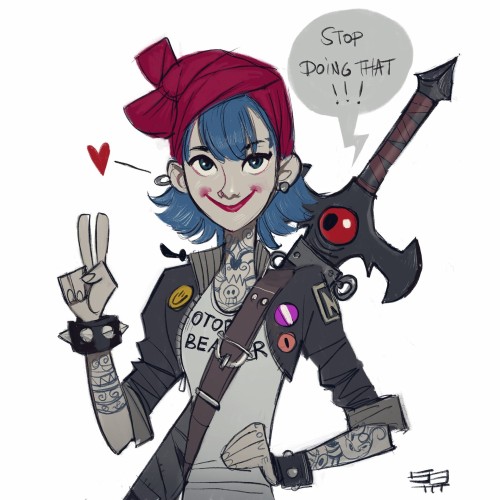
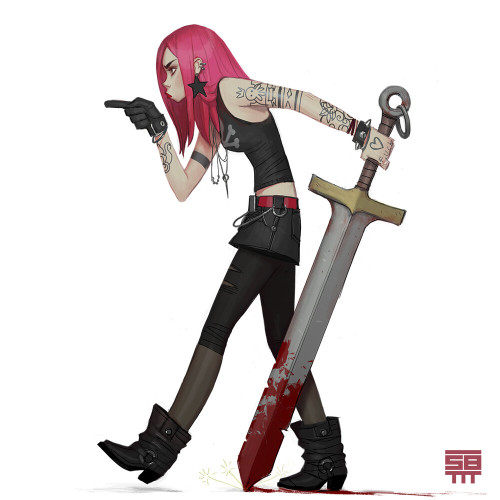
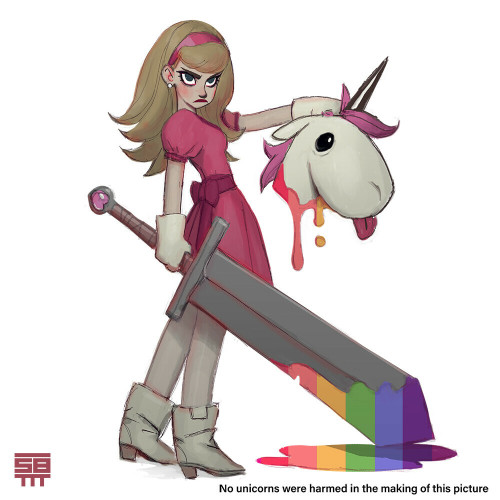
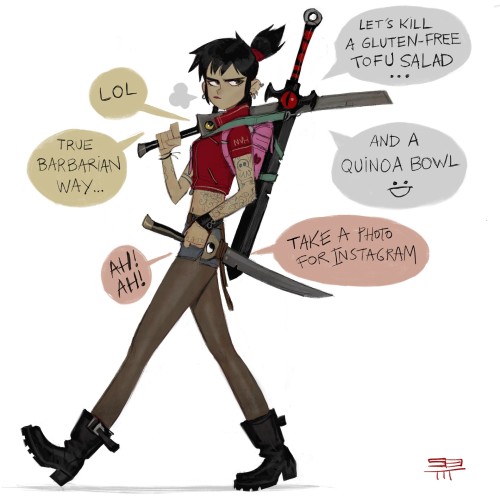
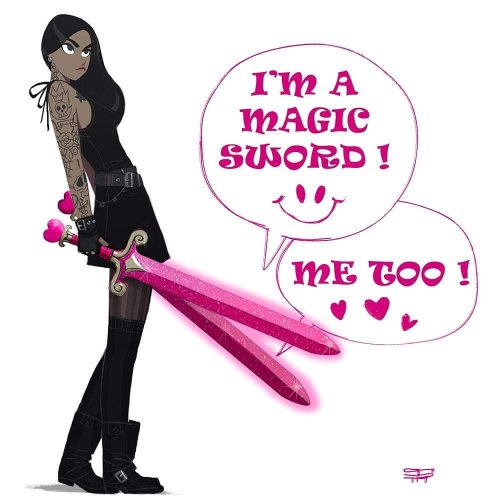
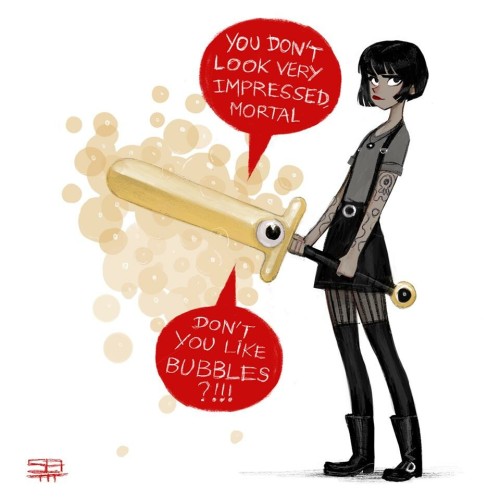
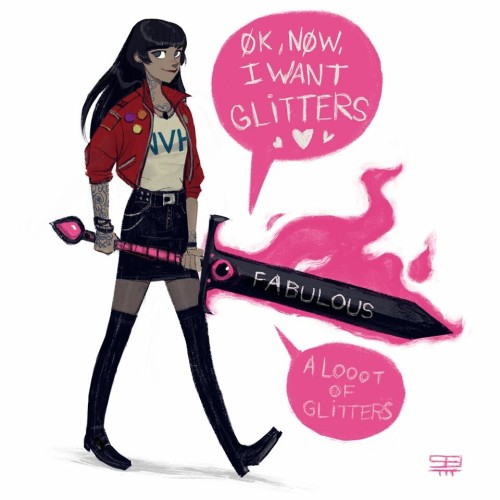
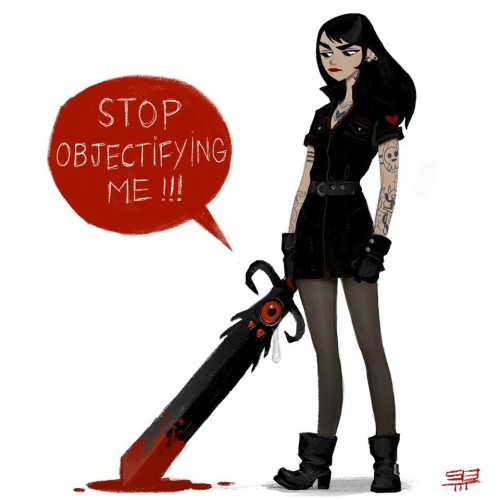
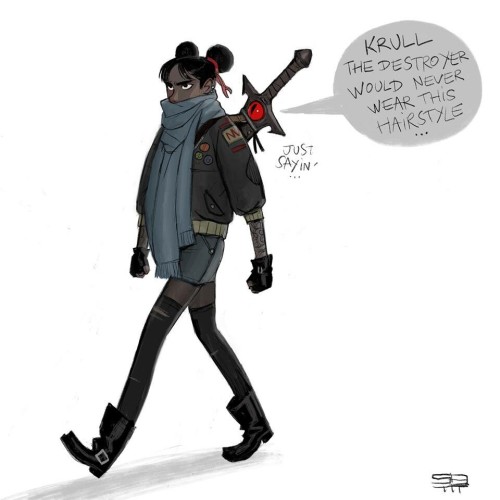
Ladies and their Magic Swords (2019)
Art by: Serge Birault
More Posts from Hazyirbis-blog and Others
Dialogue Tag Options Other Than "Said"
Writing "said" repeatedly in creative writing projects isn't necessarily bad. "Said" can be an excellent tool to support the flow of your prose. It can function like picture frames on a wall. It adds to your manuscript, but your readers may only read the whole dialogue tag occasionally.
Still, there can definitely be times when "said" gets used too many times in a row. Descriptive dialogue tags can add tension, variety, and depth to crucial moments in your manuscript.
Need a creative boost? Here's an extensive list of dialogue tag options besides "said."
Dialogue Tag Alternatives to "Said"
Acknowledged
Added
Agonized
Agreed
Announced
Apologized
Approved
Articulated
Asserted
Babbled
Backtracked
Bawled
Beamed
Began
Blubbered
Blurted
Bubbled
Called
Chattered
Cheered
Chimed in
Chortled
Chuckled
Commented
Communicated
Conferred
Congratulated
Complimented
Considered
Contended
Cried
Crooned
Declared
Denoted
Drawled
Elaborated
Emitted
Ended
Enunciated
Exclaimed
Expounded
Expressed
Giggled
Greeted
Grinned
Groaned
Gushed
Interjected
Jabbered
Joked
Laughed
Mentioned
Moaned
Mumbled
Noted
Observed
Orated
Persisted
Praised
Predicted
Pronounced
Quipped
Recited
Reckoned
Rejoiced
Related
Remarked
Repeated
Replied
Responded
Sang
Screeched
Shared
Slurred
Stated
Smiled
Snarled
Spat
Suggested
Swore
Thanked
Tittered
Told
Trilled
Urged
Uttered
Yammered
Yelled
Vocalized
Voiced
Other Helpful Resources
Need more inspiration? Here are a few other sources you can check out:
350 Other Words Than Said
Different Words to Use Instead of Said
500 Dialogue Tags Examples
Should You Always Use Dialogue Tags?
You don't have to! Conversations often happen in all genres of creative writing without constant dialogue tags. Once you establish who's saying what, you can format a conversation like this:
"You don't know what you're talking about," Joe said.
"Of course I do," Lucy replied, rolling her eyes. "I only got a Ph. D. in Chemistry."
"From one of the worst universities in the country."
"It's still accredited."
"Your thesis advisor was just arrested for academic fraud!"
"And yet I still passed all my finals."
You can keep up with who's saying what and the tone behind their voices without a tag for each line of dialogue. I wouldn't recommend doing that with every conversation (especially extensive ones) but you can take a break from tags if people are talking rapidly back and forth or if you just want to take a break.
---
You'll know how to handle dialogue tags and descriptors as you practice. Reading your manuscript out loud can also point out when they're clunky or unnecessary. There's a necessary balance to making tags that you'll find more easily with each draft!











Handler
Do you like Kakashi's dogs? Let's talk about why there are eight of them.
another example of naruto's ✨cultural code✨
contents | the eight dog warriors chronicles · legacy · eight confucian virtues. also look at the cuties love them sm

Naruto Vol. 10 CH 90
[ one dog is wonderful, I'm saying as the owner of a sweet little york terrier. two dogs are good, they won't be bored together. three dogs? yeah, cool! how are you going to walk them though? four? yes... look, maybe we have to draw the line h- wha- EIGHT? Excuse Me!? ]
surely, it's worth starting with the fact that eight is a lucky number in Japanese culture — everybody watched Hachi. of course, this is not the only cultural detail where the eight is mentioned. I want to pay special attention to a thing that I didn't know about until I googled it, and this is clearly what Kishimoto was doing homage to with Kakashi's eight ninken.
The Eight Dog Warriors Chronicles
Better known as Nansō Satomi Hakkenden. and it's not just some kind of book, it's a novel, consisting of 106 booklets written by Kyokutei Bakin in XIX century. Hakkenden is considered the largest novel in the history of Japanese Literature. this is one of the main representatives of the gesaku genre, which includes works of a frivolous, joking, silly nature. further I will emphasize a few more times how damn popular this work is and how often it is reflected in culture.



here are some illustrations for these books
now let's talk about the plot. It's weird, but it's weird at samurai-dogs-story level so stay here.
In brief, the story tells about the commander Satomi Yoshizane, whose native lands were attacked by the army of a man, whose forces surpassed those of Satomi, and the samurai in despair swore to a dog named Yatsufusa that the dog would get his beloved daughter Fuse as a wife if he chewed that man's throat. surprisingly, the dog not only understood the owner, but also fulfilled his wish! after that the commander refused to keep the promise. however, Fuse, true to her word of honor, went with Yatsufusa to the mountains and became his wife. upon learning that his daughter was pregnant, Satomi, in a rage, sent a samurai to kill Yatsufusa and bring Fuse home. she stood up for the dog anyways and died with him. at that moment, eight pearls with hieroglyphs that denoted the foundations of Confucian virtue burst out of her womb. (...cheers for mythology, I guess)
Soon, eight dog warriors who were Fuse's spiritual children were born in different parts of Awa province. after going through hardships, they got together and became vassals of the Satomi clan, then won the battle, and soon reached peace.



some more illustrations made by Utagawa Kuniyoshi. from left to right: Inukawa Sōsuke (the dog warrior), Inumura Daikaku (the dog warrior), Princess Fuse (their mother).
the novel mainly tells about each individual warrior dog and his shenanigans in a funny adventurous way. huge fame has led to excerpts from Hakkenden being staged at the Kabuki Theater and mentioned in the anime and manga, such as Inuyasha, Dragon Ball, as it turned out, Naruto and so on. there's also a lot of films and video games.
The eight virtues
these are loyalty, filial piety, benevolence, love, honesty, justice, harmony, and peace.
they relate more to Chinese culture, but basically Hakkenden was inspired by it too. since I did not read the whole novel, I would still like to mention at least the values on which it is based, and which were embedded in the symbolism of this story. It's quite interesting to apply this to Kakashi's dogs. gives them more weight and depth.
It is also interesting to note that the reason why Fuse gave birth to dogs was also that her father was cursed earlier in the story in a way that his descendants would become depraved like dogs. in Japanese culture, dogs embody the duality of character: the same mentioned filth and depravity, and devotion and bravery. so as samurai. but this is a different conversation, more related to Kakashi and his dog poetry.

Did you get here? Here's an additional discovery for you✨
Pakkun's name (パックン) is derived from the Japanese onomatopoeia “pakupaku” (パクパク) which reflects the sound of munching.
Kakashi, that's very sweet of you.

thank you for reading this to the end ♡
Not that anybody asked, but I think it's important to understand how shame and guilt actually work before you try to use it for good.
It's a necessary emotion. There are reasons we have it. It makes everything so. much. worse. when you use it wrong.
Shame and guilt are DE-motivators. They are meant to stop behavior, not promote it. You cannot, ever, in any meaningful way, guilt someone into doing good. You can only shame them into not doing bad.
Let's say you're a parent and your kid is having issues.
Swearing in class? Shame could work. You want them to stop it. Keep it in proportion*, and it might help. *(KEEP IT IN PROPORTION!!!)
Not doing their homework? NO! STOP! NO NOT DO THAT! EVER! EVER! EVER! You want them to start to do their homework. Shaming them will have to opposite effect! You have demotivated them! They will double down on NOT doing it. Not because they are being oppositional, but because that's what shame does!
You can't guilt people into building better habits, being more successful, or getting more involved. That requires encouragement. You need to motivate for that stuff!
If you want it in a simple phrase:
You can shame someone out of being a bad person, but you can't shame them into being a good person.
someone recommend me some good fantasy books that aren’t centred on a war, please, my crops are dying










I'm the one who ruined me: I did it myself
No Longer Human // Ask Polly: Help, I'm The Loneliest Person In The World! // Franz Kafka // Sue Zhao // Fingertips - Fortesa Latifi // Crime and Punishment - Fyodor Dostoevsky // Juansen Dizon // The Garden of Eden - Ernest Hemingway // On Earth We're Briefly Gorgeous - Ocean Vuong



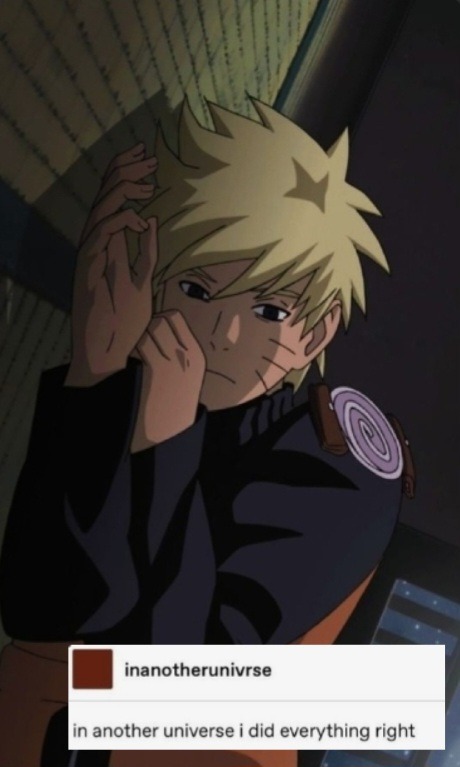






in another universe
Listen, what if Naruto and Menma met? What if Naruto wants out of the shadows and anonymous lifestyle? What if Menma craves anonymity without his Father/Brother shadows hanging over him? And if we already have prince and a pauper situation , both of them raised by Kakashi/Obito why not parent trap them?
I know what I’m drawing next I’m writing it here so I don’t forget later. Minato chooses the village instead of Naruto so obito has to kill the baby Naruto but he looks at Naruto’s big turnip head and googoo gaga eyes and is like “fuck idk” and he runs off with Naruto and is standing there with a rock like “I don’t want to be a dad I have to kill this baby and mail the body parts to Minato.” But Naruto is like googoogaga and obito is like ok fine you convinced me
WEBSITES FOR WRITERS {masterpost}
E.A. Deverell - FREE worksheets (characters, world building, narrator, etc.) and paid courses;
Hiveword - Helps to research any topic to write about (has other resources, too);
BetaBooks - Share your draft with your beta reader (can be more than one), and see where they stopped reading, their comments, etc.;
Charlotte Dillon - Research links;
Writing realistic injuries - The title is pretty self-explanatory: while writing about an injury, take a look at this useful website;
One Stop for Writers - You guys... this website has literally everything we need: a) Description thesaurus collection, b) Character builder, c) Story maps, d) Scene maps & timelines, e) World building surveys, f) Worksheets, f) Tutorials, and much more! Although it has a paid plan ($90/year | $50/6 months | $9/month), you can still get a 2-week FREE trial;
One Stop for Writers Roadmap - It has many tips for you, divided into three different topics: a) How to plan a story, b) How to write a story, c) How to revise a story. The best thing about this? It's FREE!
Story Structure Database - The Story Structure Database is an archive of books and movies, recording all their major plot points;
National Centre for Writing - FREE worksheets and writing courses. Has also paid courses;
Penguin Random House - Has some writing contests and great opportunities;
Crime Reads - Get inspired before writing a crime scene;
The Creative Academy for Writers - "Writers helping writers along every step of the path to publication." It's FREE and has ZOOM writing rooms;
Reedsy - "A trusted place to learn how to successfully publish your book" It has many tips, and tools (generators), contests, prompts lists, etc. FREE;
QueryTracker - Find agents for your books (personally, I've never used this before, but I thought I should feature it here);
Pacemaker - Track your goals (example: Write 50K words - then, everytime you write, you track the number of the words, and it will make a graphic for you with your progress). It's FREE but has a paid plan;
Save the Cat! - The blog of the most known storytelling method. You can find posts, sheets, a software (student discount - 70%), and other things;
I hope this is helpful for you!
(Also, check my gumroad store if you want to!)
-
 hazyirbis-blog reblogged this · 2 weeks ago
hazyirbis-blog reblogged this · 2 weeks ago -
 bipbopbip-nem liked this · 3 weeks ago
bipbopbip-nem liked this · 3 weeks ago -
 scywritesbynight liked this · 3 weeks ago
scywritesbynight liked this · 3 weeks ago -
 mxmarkargent reblogged this · 4 weeks ago
mxmarkargent reblogged this · 4 weeks ago -
 ashbet liked this · 4 weeks ago
ashbet liked this · 4 weeks ago -
 w-e-chard liked this · 4 weeks ago
w-e-chard liked this · 4 weeks ago -
 pyrriae reblogged this · 4 weeks ago
pyrriae reblogged this · 4 weeks ago -
 tabletoptime reblogged this · 4 weeks ago
tabletoptime reblogged this · 4 weeks ago -
 aricana8 liked this · 4 weeks ago
aricana8 liked this · 4 weeks ago -
 addie-lover-of-stories liked this · 4 weeks ago
addie-lover-of-stories liked this · 4 weeks ago -
 youremysunshine8 liked this · 4 weeks ago
youremysunshine8 liked this · 4 weeks ago -
 brianna172 liked this · 4 weeks ago
brianna172 liked this · 4 weeks ago -
 continuousincoherentscreaming liked this · 4 weeks ago
continuousincoherentscreaming liked this · 4 weeks ago -
 ahumansvoid reblogged this · 4 weeks ago
ahumansvoid reblogged this · 4 weeks ago -
 ahumansvoid liked this · 4 weeks ago
ahumansvoid liked this · 4 weeks ago -
 basil-22 reblogged this · 4 weeks ago
basil-22 reblogged this · 4 weeks ago -
 basil-22 liked this · 4 weeks ago
basil-22 liked this · 4 weeks ago -
 joyrose-fandomer liked this · 4 weeks ago
joyrose-fandomer liked this · 4 weeks ago -
 unstablebloodandfoam liked this · 4 weeks ago
unstablebloodandfoam liked this · 4 weeks ago -
 visibun reblogged this · 4 weeks ago
visibun reblogged this · 4 weeks ago -
 visibun liked this · 4 weeks ago
visibun liked this · 4 weeks ago -
 cryptids-and-muses reblogged this · 4 weeks ago
cryptids-and-muses reblogged this · 4 weeks ago -
 cryptids-and-muses liked this · 4 weeks ago
cryptids-and-muses liked this · 4 weeks ago -
 tenaciousrunawaybouquet liked this · 4 weeks ago
tenaciousrunawaybouquet liked this · 4 weeks ago -
 veidrazel reblogged this · 4 weeks ago
veidrazel reblogged this · 4 weeks ago -
 veidrazel liked this · 4 weeks ago
veidrazel liked this · 4 weeks ago -
 biohaphazard reblogged this · 4 weeks ago
biohaphazard reblogged this · 4 weeks ago -
 thepunchanz reblogged this · 4 weeks ago
thepunchanz reblogged this · 4 weeks ago -
 acereybus liked this · 4 weeks ago
acereybus liked this · 4 weeks ago -
 indigopuppy liked this · 4 weeks ago
indigopuppy liked this · 4 weeks ago -
 againstadarkbackground liked this · 4 weeks ago
againstadarkbackground liked this · 4 weeks ago -
 rannulfr liked this · 4 weeks ago
rannulfr liked this · 4 weeks ago -
 funkelnderdia liked this · 4 weeks ago
funkelnderdia liked this · 4 weeks ago -
 etherviolet liked this · 4 weeks ago
etherviolet liked this · 4 weeks ago -
 theuwusmol reblogged this · 4 weeks ago
theuwusmol reblogged this · 4 weeks ago -
 theuwusmol liked this · 4 weeks ago
theuwusmol liked this · 4 weeks ago -
 knit-braid liked this · 4 weeks ago
knit-braid liked this · 4 weeks ago -
 runcibility reblogged this · 4 weeks ago
runcibility reblogged this · 4 weeks ago -
 thirtyknives reblogged this · 4 weeks ago
thirtyknives reblogged this · 4 weeks ago -
 thirtyknives liked this · 4 weeks ago
thirtyknives liked this · 4 weeks ago -
 darksideblargh liked this · 1 month ago
darksideblargh liked this · 1 month ago -
 friendlywoodlandboi reblogged this · 1 month ago
friendlywoodlandboi reblogged this · 1 month ago -
 talented-bitch liked this · 1 month ago
talented-bitch liked this · 1 month ago -
 pricklythepearcat reblogged this · 1 month ago
pricklythepearcat reblogged this · 1 month ago -
 pricklythepearcat liked this · 1 month ago
pricklythepearcat liked this · 1 month ago -
 royaltystudios liked this · 1 month ago
royaltystudios liked this · 1 month ago -
 rumplefuckingstiltzkin reblogged this · 1 month ago
rumplefuckingstiltzkin reblogged this · 1 month ago -
 galaxygal618 liked this · 2 months ago
galaxygal618 liked this · 2 months ago -
 amblyopsidae reblogged this · 2 months ago
amblyopsidae reblogged this · 2 months ago -
 someguytm liked this · 2 months ago
someguytm liked this · 2 months ago